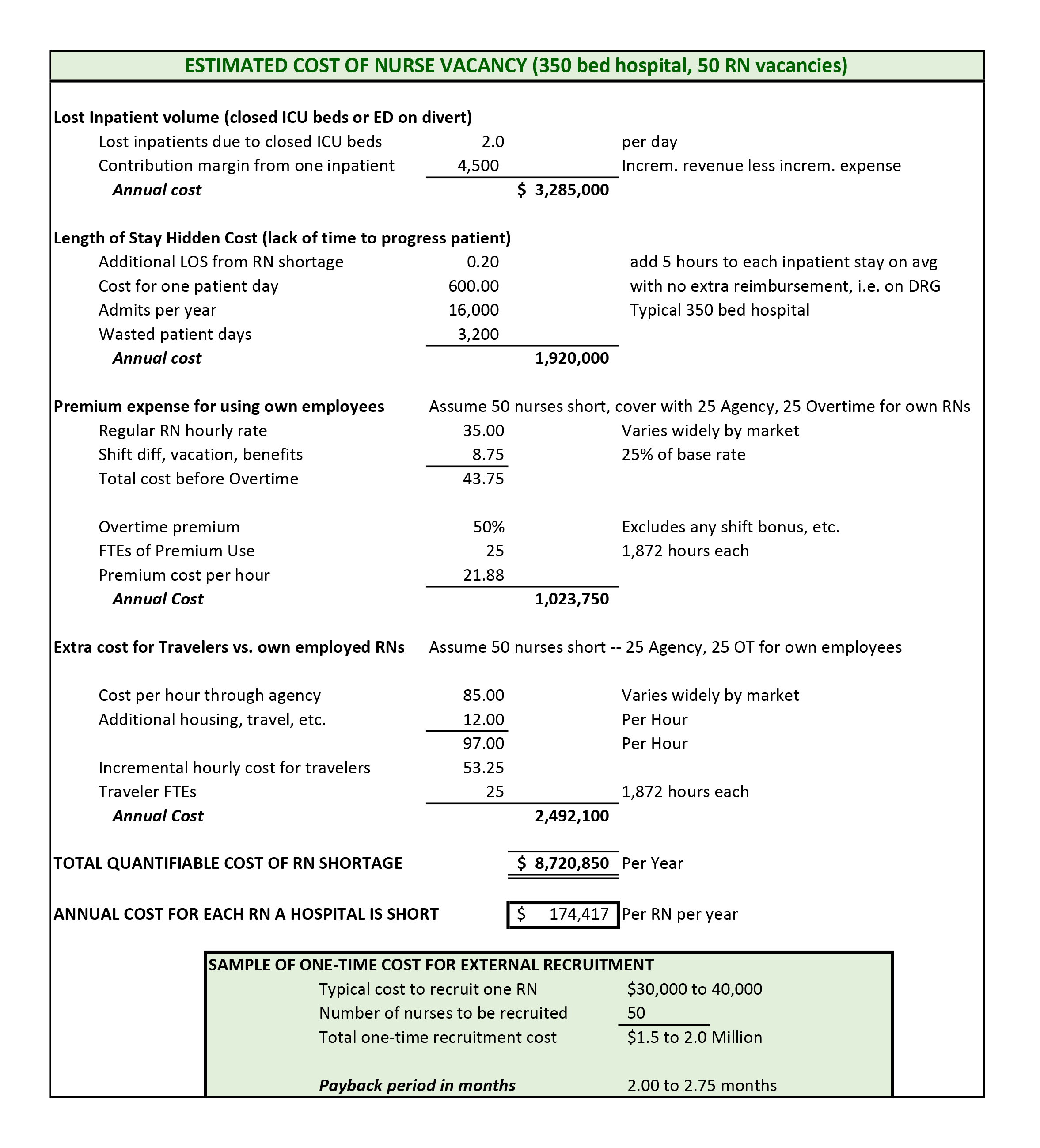Most hospital leaders would be intrigued if told they could save several million dollars.
All hospitals have nursing vacancies, and it is easy to underestimate the true cost of open nursing positions. By recruiting for nursing vacancies effectively, a hospital can stop the loss of a large outflow of expense.
Nursing is a hard job. Expectations of an RN never seem to end. Working as a nurse under ideal conditions is hard enough – working understaffed is demoralizing and dangerous. Nurses are the front line in the delivery of safe care and patient satisfaction.
Computing the economic value delivered by a nurse requires looking at some often overlooked but real costs. When we fail to quantify the economic value delivered by a nurse, it is easy to miss the importance and urgency of effective recruitment.
What does it cost an organization to not have enough qualified nurses? There are several elements of this cost:
Lost patient volume. When there aren’t enough nurses, patients end up being routed to competitors, resulting in lost revenue. For example, an understaffed Emergency Department may go on ambulance divert, redirecting profitable admissions to other hospitals. Likewise, a hospital without enough critical care nurses may close ICU beds, causing patients in the Emergency Department to be transferred to a competing hospital. We estimate that a typical inpatient admission produces a $4,000 to $5,000 positive contribution (incremental revenue less incremental expense), so losing even two patients per day (a likely loss per hour for a medium to large hospital) could cause a $3.3 Million loss annually.
High cost of agency or travelers. While there are many excellent nurses who choose to work for an agency, achieving the level of local knowledge, ownership and engagement is harder for a nurse who is not permanently at a hospital. There are many costs, such as high hourly rate, housing and travel expenses, and lapses in knowledge from nurses not fully oriented locally. The total cost of an RN traveler could be 50-100% higher than the all-in cost of an employed nurse. Having 25 travelers covering vacancies could well cost $2.5 Million of unnecessary expense.
Premium expense of using own employees. Overtime, extra shift bonus payments, burnout and fatigue factor are all costly downsides of overworking existing employed nurses. Having your own nurses work overtime costs at least 50% higher than regular rates, or more if there are additional shift bonuses or other premiums.
Hidden costs of understaffing. Not having enough nurses can result in a poor patient experience or increased potential to miss important clinical cues. Understaffing is highly obvious to patients, their families and physicians, possibly leading to a choice to use your competitor for future care. Nurses that don’t have time to be proactive in their patient care often translates directly into a longer length of stay, costing $600-900 per day with no additional reimbursement.
When leadership understaffs patient care, we create strong dissonance between what we say and what we do. When leaders state they’re committed to great patient care but fail to resource accordingly, it creates distrust of leadership, low morale and more turnover.
In the attached example, we model the costs for a typical 350 bed hospital with 50 nursing vacancies, half covered with travelers and half with existing employee overtime. The cost per vacancy can be astounding, in this example over $170,000 per year, per RN. Given this enormous cost, it highlights the need to be proactive and intentional, to retain existing nurses and quickly recruit the right talent when vacancies occur.
So what can a hospital do to avoid these high costs? This should lead to a careful evaluation of current recruitment efforts. If vacancies are under 3-4% of total RN staff, the current process may be working effectively. If it is higher than this, an alteration to the existing approach is probably necessary. What is clear is that the cost of doing nothing is costly indeed.

August 2018
Debra Pollick, RN, MS
EVP/COO, Volume Recruitment Services
(303) 838-9286
Debra.Pollick@VolumeRecruitmentServices.com
VolumeRecruitmentServices.com
Ron Benfield, FACHE
CEO, Millwood Associates
(360) 719-1200
RBenfield@MillwoodAssociates.com
MillwoodAssociates.com
Author Bios:
Debra Pollick, RN, MS is Executive Vice President / COO of Volume Recruitment Services, a high-volume staff recruitment company focusing on permanent placement of hard-to-fill positions such as Registered Nurses and Allied Health. Using a retained search process enables the teams to place qualified candidates quickly and efficiently with return on investment in most cases in a matter of weeks/months. Volume Recruitment Services stabilizes organizations acute, permanent recruitment needs. Prior to VRS, Debra, a former nursing leader, has over 30 years in the retained search focusing on health care.
Ron Benfield, FACHE is CEO of Millwood Associates, an organization committed to helping hospitals strengthen their financial position to ensure sustainability of mission. Prior to founding Millwood Associates, Ron served as a senior healthcare executive for over thirty years, bringing skills in healthcare operations, finance, strategic planning, clinical service lines, managed care and revenue cycle. He has functioned as both Chief Financial Officer and Chief Operating Officer, in diverse healthcare markets in California, Ohio, Tennessee, Florida, Maryland, Oregon and Washington.


